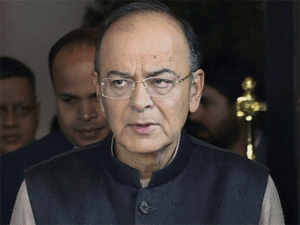 PTI
PTIBlowing the Budget in a pre-election year is expected. But doing so two years ahead is unusual. While the 2018-19 shortfall of 30 basis points can be explained by elections, the 2017-18 shortfall is largely due to the fallout of self-inflicted wounds. The latter is disappointing for two reasons. On the revenue side, it is not, as was expected, due to GST or broader tax collections, which are up.
This sign of improved tax buoyancy portends well for the coming year. It is because of shortfall in non-tax revenue due to a smaller RBI dividend — blame it on demonetisation — and spectrum licence.
On the expenditure side, the surprise is the increase in revenue expenditure by around 0.7% of GDP, due to pensions (One Rank, One Pension (Orop) included) and wages (7th Pay Commission) — and a surprising shortfall in capex spend by 0.2% of GDP. This has resulted in a worrisome increase in the revenue deficit by 0.5% of GDP, larger even than the increase in the fiscal deficit. Disinvestment receipts are up by 0.2% of GDP. But selling one public company, HPCL, to another, ONGC, is not genuine disinvestment. Not factoring in this one deal would increase the fiscal deficit to around 3.7% of GDP.
The fiscal math looks much better for 2018-19. If the tax buoyancy is genuine, tax revenue could go up by around 0.5% of GDP. Disinvestment receipts have been kept at Rs 80,000 crore, despite an achievement of Rs 1 lakh crore this year, which provides a cushion in case tax revenue increases do not materialise.
The main risk in this Budget is the large number of underfunded big announcements, such as ‘Modicare’ and minimum support price (MSP) increases. The increase in GoI securities yields are already reflecting that risk.
Given the Gujarat election results and widespread farm distress, this had to be a ‘Jai Kisan’ Budget. Substantially higher MSPs could end up stoking inflation and, worse still, locking in unproductive crop patterns indefinitely. It would have been more equitable to start a shift to income support to small farmers, as India is one of few countries that still provides crop-specific farm price support, which largely benefits large farmers. Such a shift would eventually get us out of product-based subsidies, which are a festering issue at the WTO.
The threat to hard-won inflation gains also comes from rising oil prices. GoI passed on only a quarter of the oil price drop from 2014-15 onwards to consumers and collared the rest for its big infrastructure push. But now prices have reversed and it has already passed on half of the increase to consumers, as it deals with huge fiscal pressure.
If oil prices were to rise another $10 a barrel, GoI may have to absorb most of it in the Budget or risk high inflation.
Defence spending has taken a hit, with an allocation of only 1.56% of GDP, the lowest in the last 50 years. This is because the funds now are needed for Orop payments, making ‘Jai Jawan’ into ‘Jai Ex-Jawan’. Capex barely keeps pace with projected nominal GDP, but within infrastructure, railways is a big winner. More infrastructure spending is now coming anyway through extra-budgetary funds.
The big game changer could be ‘Modicare’, an ambitious health insurance of Rs 5 lakh for some 100 million families. For poor families with large health costs that can knock families back into poverty, this scheme can be a godsend. GoI has set aside Rs 10 lakh crore for the scheme to be financed by a 1% income-tax cess. But it may end up costing 5-10 times that amount. One hopes this one has a better fate than the one announced two years ago with a coverage of Rs 1 lakh a family. The reduction in corporate tax to 25% for micro, small and medium enterprises (MSMEs) is welcome.
Large corporates take numerous exemptions, and anyway pay an effective corporate tax lower than that. Together with the extension of fixed employment contracts, this will boost MSMEs and exports.
Protectionism surprisingly raised its ugly head with tariff increases on some 50 items. It has been tried before. But it has made India a costly producer of shoddy products, with high costs to consumers. They are easy to slap on but difficult to remove. A 20% correction in the over-valued exchange rate, which the longterm capital gains (LTCG) tax may help achieve, would do more for ‘Make in India’ than a reversion to trade barriers.
India needs an open global economy. It shouldn’t hide behind protective walls. Let us hope we go back to that strategic trade and industrial policy after the elections.
*The writer is Chief Economic Advisor , FICCI and Distinguished Visiting Professor, NIPFP. Views here are personal.
Download The Economic Times News App to get Daily Market Updates & Live Business News.
Subscribe to The Economic Times Prime and read the ET ePaper online.
Read More News on
Download The Economic Times News App to get Daily Market Updates & Live Business News.
Subscribe to The Economic Times Prime and read the ET ePaper online.









 Get Unlimited Access to The Economic Times
Get Unlimited Access to The Economic Times
